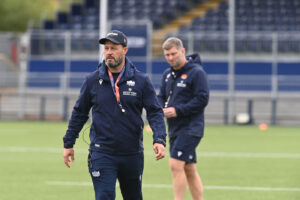When the latest high‑profile diagnosis of Lewis Moody with motor neurone disease (MND) was announced, many in the rugby world felt a familiar and terrible resonance. But his case also resurrected a statistic that is often cited quietly and with dread: “1 in 300 people will develop MND in their lifetime.”
That figure is sometimes repeated in awareness campaigns and media accounts — but what does it really mean? And when that statistic intersects with the legacy of Doddie Weir and Scottish rugby, it demands closer scrutiny.
The “1 in 300” Risk: What the Numbers Say
The MND Association states clearly that the lifetime risk of developing motor neurone disease is about 1 in 300. 
This means that across a population, one person in approximately every three hundred might, during their lifetime, be diagnosed with MND. It is a risk that is small in absolute terms but significant because of the severity and rapid progression of the disease.
Importantly, because MND is often fatal within a few years, prevalence (how many people are living with it at a given time) is much lower. The MND Association’s “Accelerating Research” briefing points out:
“Because people die so quickly, only 5,000 live with the disease at any one time. But MND is not rare – 1 in every 300 people, across all communities, will develop MND in their lifetime.” 
In Scotland, the public face of MND was forever changed when Doddie Weir, former Scotland lock and British & Irish Lion, was diagnosed in 2016. His condition and his campaigning brought unprecedented focus in Scotland on MND’s risks, research, and personal toll.
Why That Risk Matters in Scottish Rugby
What makes the “1 in 300” statistic particularly resonant in Scottish rugby is that it brings into sharp relief how fragile the boundary between ordinary life and catastrophe can be — even for athletes. To a community steeped in rugby culture, the idea that one’s risk is nonzero is a haunting one.
Yet, that figure is a population-level average. The real questions — and the most urgent ones — concern whether certain groups, such as former rugby players, have a higher-than-average risk, and if so, why.
Evidence of Elevated Risk Among Scottish Rugby Players
In 2022, a landmark study in the Journal of Neurology, Neurosurgery & Psychiatry found that former Scottish international rugby union players had a statistically greater incidence of neurodegenerative disease (including MND) than matched controls from the general population.  The study is often cited in media reports as supporting the notion that elite rugby players face a higher risk. 
But the same researchers and MND charities are careful to emphasise correlation, not causation. The MND Association itself states:
“While these studies … suggest a correlation between these professional sports and MND they don’t demonstrate causation.” 
In other words: footballers and rugby players may appear more often in the statistics, but it is not yet proven that their sport caused their disease.

The Scottish Dimension: What the “1 in 300” Means Here
1. Raising Awareness in the Scottish Community
For Scottish rugby fans and former players, the “1 in 300” statistic is more than an abstract risk — it is a warning that vigilance is needed. Awareness campaigns in Scotland, bolstered by Doddie’s legacy, can help ensure earlier diagnosis, better support, and more research focus in Scottish institutions.
2. Mobilising Scottish Research Institutions
Scottish universities (notably Glasgow, Aberdeen, Edinburgh) and medical research bodies are well placed to lead on exploring the interplay of genetics, environment, and sport-specific exposures in MND. The “1 in 300” baseline can be a rallying metric to lobby for Scottish funding and infrastructure.
3. Player Welfare Policy in Scottish Rugby
Given that the statistic applies across all communities, Scottish Rugby Union (SRU), clubs, and academies might explore whether certain protocols — e.g. concussion monitoring, training loads, rest cycles — can be refined to minimise any avoidable risk factors, even if causation is not yet established.
4. Support for Affected Individuals and Their Families
Even if only one in 300 people is affected in their lifetime, the Scottish rugby community has already seen tragic cases like Doddie Weir. Providing support networks, medical information, and emotional assistance for ex-players and their families is vital.
Why the Statistic Must Be Treated Carefully — and Courageously
• It is a population average, not a guarantee. Many (most) people will never develop MND, even if they carry genetic risk factors.
• It does not identify who is at risk — there is no clinical test that says, “You are the one in 300.”
• It can cause fear if misinterpreted — especially among former athletes. That is why clarity, context, and responsible journalism matter deeply.
But those variables are not a reason to shy away from the discussion. Rather, it is a call to better science, better support, and better public understanding.
A Scottish Call to Action
The “1 in 300” figure reminds us that MND is never far from human possibility. For Scotland, with a national hero like Weir whose fight redefined the conversation, this statistic carries extra weight. To confront it, the Scottish rugby world can:
• Commission or support longitudinal studies of Scottish players and ex-players
• Advocate for research funding targeted at Scottish initiatives
• Support MND education and screening programs in the rugby community
• Strengthen medical support for ex-professionals exposed to heavy physical loads
• Keep Doddie’s memory alive by continuing to press for collaboration and transparency in MND science
Doddie Weir’s legacy is not just emotional — it is institutional and scientific. The statistic is sobering, but we already see it becoming a catalyst: a lens through which, in Scotland, we view sport, health, and risk with clarity and objectivity.




